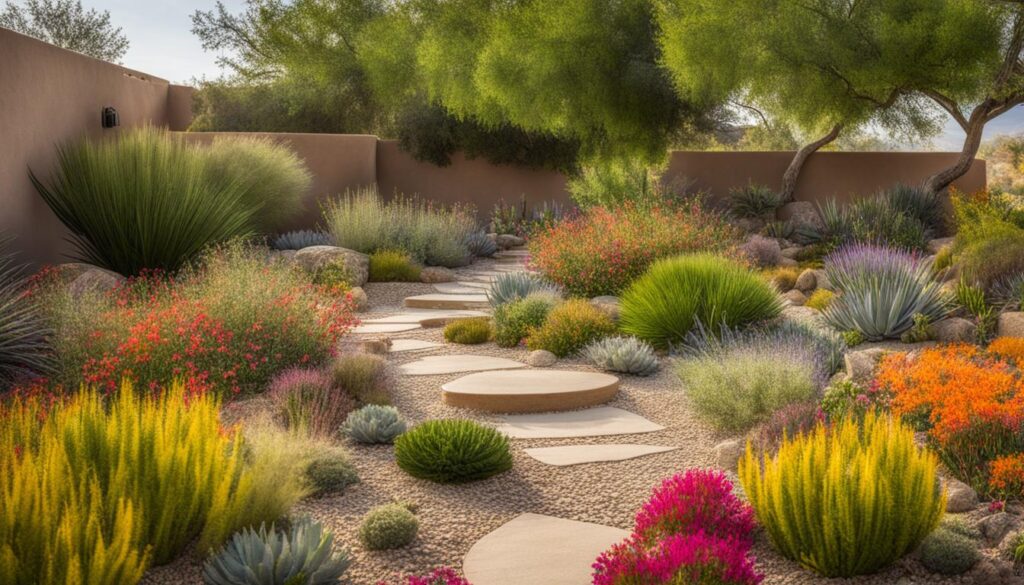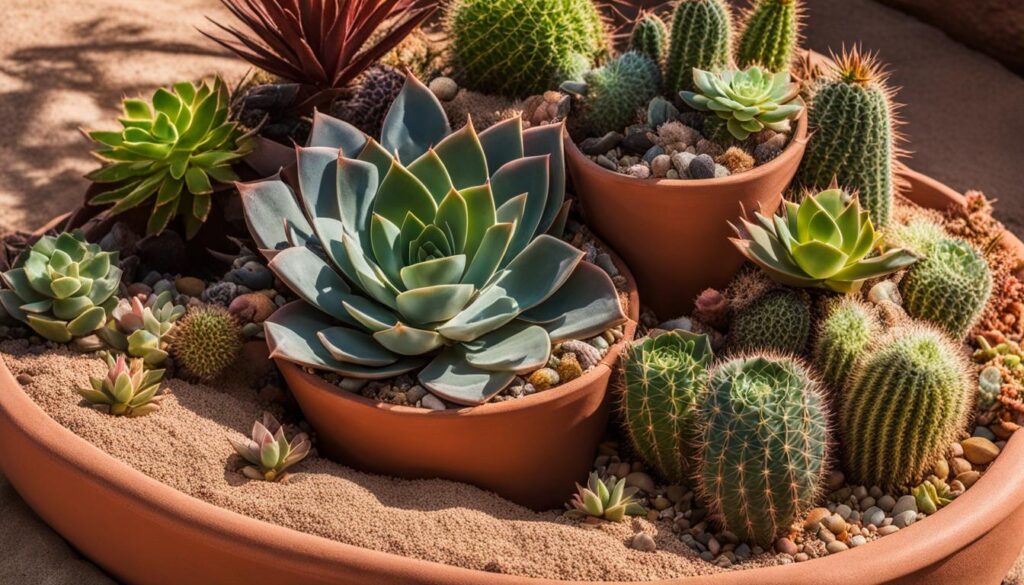Are you ready to transform your landscape into a beautiful, water-wise oasis? Look no further than the art of xeriscaping. By designing a xeriscape yard, you can create a low-maintenance, eco-friendly space that thrives even in the driest of climates. In this complete guide, we will walk you through the process of planning and designing a stunning xeriscape yard layout that will not only conserve water but also enhance the aesthetic appeal of your outdoor space.
Key Takeaways:
- Xeriscaping focuses on water conservation and drought-tolerant plants.
- Native plants and soil amendments are key components of xeriscape yard design.
- Consider sun and shade requirements, plant water needs, and soil preferences when selecting plants.
- Implement efficient irrigation systems and explore rainwater harvesting options for water conservation.
- Xeriscaping offers benefits such as cost savings, reduced maintenance, and increased biodiversity.
Understanding Xeriscaping and Its Benefits
Xeriscaping is a landscaping approach that promotes water conservation and utilizes drought-tolerant plants. It is an ideal solution for homeowners looking to create beautiful outdoor spaces while minimizing water usage and maintenance. By incorporating xeriscaping techniques into your yard, you can enjoy numerous benefits, including:
- Water Conservation: Xeriscaping significantly reduces water consumption by utilizing plants that are adapted to arid climates. These drought-tolerant plants require minimal irrigation, thereby conserving water resources.
- Low Maintenance: Xeriscaping minimizes the need for regular watering, mowing, and fertilizing. The use of native plants and mulch helps create a self-sustaining ecosystem that requires less maintenance.
- Cost Savings: By reducing the need for excessive irrigation and maintenance, xeriscaping can lead to significant cost savings in water bills and landscaping expenses.
- Increased Biodiversity: Xeriscape yards attract a wide range of wildlife, including birds, butterflies, and beneficial insects. By incorporating native plants into your landscape, you can support local ecosystems and promote biodiversity.
Implementing xeriscaping techniques not only benefits the environment but also enhances the visual appeal of your yard. Xeriscape yards can be just as vibrant and beautiful as traditional landscapes, offering a sustainable and water-efficient alternative for homeowners.
Planning Your Xeriscape Yard Layout
Designing a xeriscape yard requires careful planning and consideration of various factors to create a beautiful and sustainable outdoor space. Here are some essential steps to help you plan your xeriscape garden layout:
Assess Sun and Shade Requirements:
Observe the amount of sunlight and shade your yard receives throughout the day. This information will help you determine which areas are suitable for sun-loving plants and which areas are better for shade-loving plants. Grouping plants based on their sun and shade requirements will ensure optimal growth and health.
Selecting Plants:
Choose plants that are well-suited to your region’s climate and require minimal water. Consider native plants, as they are already adapted to local conditions and tend to have lower water needs. Additionally, select plants that complement one another in terms of color, texture, and form to create an aesthetically pleasing landscape.
Create a Garden Plan:
Develop a detailed garden plan that incorporates your chosen plants and their water needs. Consider the mature size of the plants to avoid overcrowding and allow for proper growth. Group plants with similar water requirements together to make watering and maintenance more efficient. Implementing a well-thought-out garden plan will ensure a visually appealing and functional xeriscape yard.
By following these steps, you can create a well-designed xeriscape yard that will thrive with minimal water usage and maintenance. Remember to consider the specific conditions of your yard, such as soil type and existing structures, when making your plan. With careful planning and plant selection, your xeriscape garden will be a beautiful and sustainable addition to your home.
Selecting Drought-Tolerant Plants for Your Xeriscape Yard
In order to create a successful xeriscape yard, it is crucial to carefully select drought-tolerant plants that can thrive in low water conditions. By choosing the right plants, you can conserve water while still enjoying a beautiful and vibrant landscape. When selecting plants for your xeriscape yard, consider their water needs, sun and shade requirements, and soil preferences.
One option is to choose succulents and cacti, which are known for their ability to store water in their leaves and stems. These plants are extremely drought-tolerant and can add unique texture and visual interest to your yard. Lavender is another great choice for a xeriscape yard, as it is drought-tolerant and attracts pollinators.
Native plants are also a fantastic option for a xeriscape yard. These plants are adapted to the specific climate and soil conditions of your region, making them naturally more resilient to drought. They also require less water, fertilizer, and pesticides compared to non-native plants. Consider grouping plants with similar water needs together to optimize water usage and create an aesthetically pleasing arrangement.
Key Points:
- Select drought-tolerant plants that can thrive with minimal irrigation.
- Choose succulents, cacti, and lavender for their drought-tolerant properties.
- Consider native plants that require less water, fertilizer, and pesticides.
- Group plants with similar water needs together for efficient water usage.
By carefully selecting drought-tolerant plants for your xeriscape yard, you can create a beautiful and sustainable outdoor space while conserving water. Remember to take into account their water needs, sun and shade requirements, and soil preferences when planning and designing your xeriscape yard. Next, we will discuss irrigation and water conservation techniques to further optimize the water usage in your xeriscape yard.
Can I Use Your Design Guide to Create My Own Xeriscape Garden?
Yes, you can absolutely use our design guide to create your own stepbystep xeriscape garden installation. Our guide provides all the necessary information and tips to help you design and install a beautiful, water-efficient xeriscape garden in your own space.
Irrigation and Water Conservation in Your Xeriscape Yard
Proper irrigation and water conservation techniques are essential for the success of your xeriscape yard. By implementing efficient watering practices, you can minimize water waste and ensure that your plants thrive with minimal water usage.
One of the key principles of xeriscaping is to use a low-pressure, drip irrigation system. This system delivers water directly to the roots of the plants, reducing evaporation and runoff. By directing water precisely where it is needed, you can prevent water waste and promote healthy plant growth.
To further conserve water in your xeriscape yard, consider installing a timer for your irrigation system. A timer allows you to optimize watering schedules and prevent overwatering. By watering your plants at the most appropriate times, you can maximize water absorption and minimize water loss.
Rainwater harvesting is another effective way to conserve water in your xeriscape yard. Consider installing rain barrels or cisterns to collect and store rainwater. This collected rainwater can then be used for irrigation, reducing your reliance on municipal water sources.
Water Conservation Tips:
- Water your xeriscape yard early in the morning or late in the evening to minimize evaporation.
- Use mulch around your plants to retain moisture in the soil.
- Avoid watering hardscapes or areas that don’t have plants.
- Regularly check for leaks in your irrigation system and repair them promptly.
By implementing these water conservation techniques in your xeriscape yard, you can create a sustainable outdoor space that not only conserves water but also thrives with minimal maintenance.
Conclusion
Designing a xeriscape yard layout offers numerous benefits, such as water conservation, low maintenance, and cost savings. By incorporating drought-tolerant plants, efficient irrigation systems, and proper mulching techniques, you can create a beautiful and sustainable outdoor space that thrives with minimal water usage.
Remember to consider factors such as sun and shade requirements, plant water needs, and soil preferences when planning and selecting plants. Group plants with similar water and sun requirements together for easier maintenance, and choose native plants that are adapted to your region’s climate for optimal growth and reduced water consumption.
With careful design and maintenance, your xeriscape yard can be an eco-friendly and vibrant addition to your home. Enjoy the benefits of water-wise landscaping while creating a beautiful outdoor space that is both sustainable and visually appealing.












